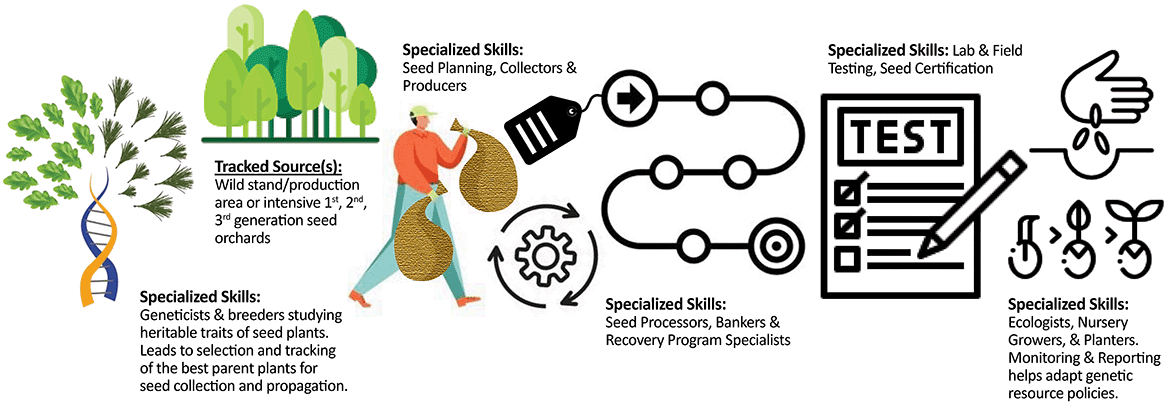National tree and shrub seed supply assessment
Executive summary
The National Tree Seed Centre led a series of surveys from 2021-2022 to try to establish a current picture of genetically-appropriate seed supply for forest landscape restoration (FLR) needs across Canada by 2030. Canada already has well-established reforestation supply chains for replanting commercial timber species in most jurisdictions. However, many reclamation and restoration practitioners are becoming or want to be involved in wild seed procurement of greater diversity of native species. This research project was designed before the launch of the 2 Billion Trees program but evolved to incorporate potential effects it may have on Indigenous communities and Canadian organizations.

Five surveys highlighted the importance of existing key players and specialized producers. For example, In 2019, 35 Canadian growers reported producing over 403 million native coniferous (91.9%) and deciduous (8.1%) seedlings and vegetative units. Just over half said it is not difficult to maintain seed source origin and the majority sourced seed and stock within Canada from a diversity of sources and distances.
There were concerns from respondents over having a diverse portfolio of seed and species to meet future demands. While there are indications that growers are storing seed of hardwoods and shrubs for longer than expected, access to tree seed surplus beyond existing reforestation supply chains appears rare or challenging. Native seed collecting and production is rarely a full-time job and requires significant skills and time to do it right. While there are emerging business opportunities in certain regions and markets, some jurisdictions do not have a great tracking and forecasting system for the origins and destinations of domestic native seed supply.
This led respondents to agree on a strong likelihood of challenging bottlenecks in the next 5 to 10 years. Primary capacity challenges beyond existing reforestation commitments were foreseen as a lack of skilled and seasonal seed collection labour, insufficient seed processing, testing and storage capacity, and a lack of skilled growers.
Many respondents identified the continuous need for adequate coordination, communication, and contractual assurances for producers. This is critical to expand their operations. Training and knowledge exchange, increased domestic spending, and optimizing productivity were the top avenues respondents would likely pursue over the next 2 to 10 years to meet new demand. Experts forecasted the specific types of restoration opportunities and the top species likely to be planted in the next 5 years.
In conclusion, the urgency to initiate forest landscape restoration (FLR) without considering genetically appropriate seed sourcing needs can force “substitute or nothing” decisions within strained regional supply chains. Inappropriate species, genotypes and poor-quality planting stock can risk the success and longevity of FLR projects. The small number of core native seed supply chain participants (115) may reveal just how concentrated, specialized, and important these existing seed supply players are in support of biodiversity in Canada. To meet carbon sequestration and biodiversity goals by 2030 and beyond, ensuring the sustainability of a robust Canadian native seed production and delivery system should be a primary concern for policymakers going forward.
Read our report Sizing Canada’s National Seed Supply Chain: Preliminary Assessment focused on Trees and Shrubs (2023)
While the NTSC is not involved in large-scale operational tree seed production or sourcing, we can support small and medium-sized enterprises and Indigenous communities grow their capacity so they can participate in the 2 Billion Trees Program. Please sign up for our newsletter, or contact us for more information.

Text version
Diagram of the seed supply chain. This includes
Tracking seed source(s): Wild stand/production area or intensive 1st, 2nd, 3rd generation seed orchards
Specialized skills: Geneticists and breeders studying heritable traits or seed plants. Leads to selection and tracking of the best parent plants for seed collection and propagation.
Specialized skills: Seed planning, collectors, and producers
Specialized skills: Seed Processors, Bankers and Recovery Program Specialists
Specialized skills: lab and field testing, seed certification
Specialized skills: ecologists, nursery growers and planters. Monitoring and Reporting helps adapt genetic resource policies.
Contact the NTSC
For more information or new support requests, please contact the National Tree Seed Centre’s general inbox: ntsc-cnsf@nrcan-rncan.gc.ca.
Indigenous communities can direct inquiries to Mary Knockwood, Indigenous Seed Collection Program Coordinator
Mobile: 1-506-434-1075
Atlantic Forestry Centre, National Tree Seed Centre
1350 Regent Street
Fredericton, NB E3C 2G6
Tel: 506-452-4162
Fax: 506-452-3525
- Genetic resources and conservation programs across Canada
- Canadian Forest Genetics Association & Tree Seed Working Group
- Canadian Forest Genetic Resources Information System
- Canadian Parks Council: Pathway to Target 1
- Hemlock Woolly Adelgid Management Plan for Canada (2018)
- Parks Canada Ecological Restoration Guidelines for Protected Areas
- Species at risk public registry
- Wild Species: The General Status of Species in Canada
- Database of Vascular Plants of Canada
- Resources used in producing hypothetical climate-based ecoregional seed procurement maps by 2070
- SeedWhere, part of the Forest Change Adaptation Toolkit
- Statistics Canada Ecological Land Classification (2017)
- Statistics for Canadian tree planting, seedling production, environmental protection spending and seed-production-related sectors
- National Forestry Database - Regeneration
- Statistics Canada Table 32-10-0031-01 Nursery tree and plant production
- Statistics Canada Environmental protection expenditures by business, 2019; supported by Table 38-10-0130-01 Capital and operating expenditures on environmental activities by industry (x 1,000,000)
- North American Industry Classification Codes
- Seed trade and quality control (national and international resources)
- A training guide for laboratory analysis of forest tree seeds in Canada (1994)
- Canada’s Country Report for The Second Report on the State of the World's Forest Genetic Resources (2022)
- CFS Publications Seed Supply
- Estimating the size of the reclamation and restoration economy and supply chain in Alberta (2021)
- Guidelines for grading and labelling forest tree seeds in Canada (1988)
- Trends in forest depletion, seed supply, and restoration in Canada during the past four decades (2001)
Page details
- Date modified: